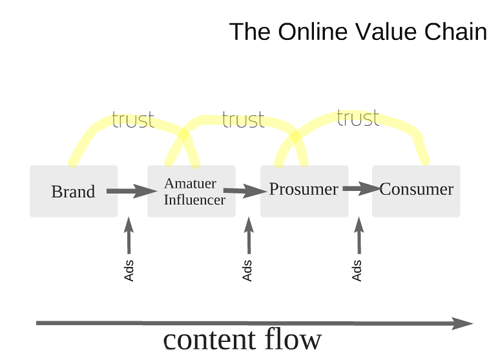Here’s a question for you. Whose word are you going to trust more? A TV ad’s or a friend’s?
Say you watch four ads for Bud Light beer over the course of a football game, though I’m guessing it’s more than that. Each ad promises the “drinkability” that you so obviously desire from your beer. You’ve just received about 2:00 of brand pitch. Do you believe the message? Are you now more likely to buy said beer? Maybe, maybe not. It’s a gamble for the brand to buy that ad time.
So now, ask yourself this. If a good friend suggested — completely unsolicited — that you try Bud Light because he or she really likes it, how likely are you to try it then?
The latter situation is, of course, an example of word-of-mouth marketing, the holy grail of brand power in the marketplace. Savvy marketers know this, and many books have been written about how to execute a solid word-of-mouth marketing strategy.
Let’s make it really simple
I’ll save you some trouble. It’s all about Trust. That’s it.
You’ll buy the Bud Light based on a friend’s recommendation because you trust their word; they’ve earned your trust. You already know they can be believed. A TV has no relationship with you. It didn’t see you cry on prom night.
So now the question becomes, how do I get consumers to trust my brand?
Give the right stuff to the right people
 To address the question, Tippingpoint Labs developed this simple chart to demonstrate the way a brand can build trust with a consumer. The Online Brand Value Chain demonstrates how brands can harness the power of online content marketing to build the trust necessary at the consumer level to influence buying decisions.
To address the question, Tippingpoint Labs developed this simple chart to demonstrate the way a brand can build trust with a consumer. The Online Brand Value Chain demonstrates how brands can harness the power of online content marketing to build the trust necessary at the consumer level to influence buying decisions.
In our model, valuable content is created to reach Amateur Influencers. These are the bloggers and web pundits who are already trusted personal brands with broad platforms but are not affiliated with a brand. They aren’t necessarily making money on their insight, but they offer a great deal of value to their audience on whatever topic they’ve chosen.
The Amateur Influencer’s most valuable audience is a group we’ve identified as Prosumers. These are the people who actively engage the Amateur Influencers and write online reviews about the products and services they use.
The last stop on the chain is the Consumers. This is the biggest and most valued audience because they are, hopefully, consuming all of your content as distributed to them via trusted Amateur Influencers and Prosumers to help steer their buying decisions. If your brand is identified with the people they trust, you are in a better position to convert.
The paradigm shift

That is a first-class lever ... literally.
This isn’t a revolutionary idea. In fact, it’s not even new. It’s the way it’s always been, with one small change: the lever to make it all happen. Before the digital world evolved, the best way to spur discussion down the chain was to interject advertising. To reach the kind of volumes necessary for a brand to get an ROI, advertising was the best way to reach the people and spread the message.
However, the lever is now Trust. Barriers to communication have been knocked down. The only way a message can carry any influence is to offer value to the consumer. This builds trust.
Takeaway
Provide valuable content to Amateur Influencers that your customers trust. Engage with them openly and honestly. Give the influencers something that they value to, in turn, earn their trust. The result will be that your message will filter down from them to the people you’re hoping to reach in a more effective way.
A message delivered from a trusted source is exponentially more powerful than one from an unknown source.
See the the Online Value Chain at the Smart Board:
Photo Credit: SeenyaRita
